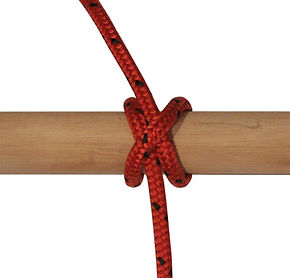Nautical Terms - page 4
1.4 Knowing the Ropes and Knots

An abiding rule with mariners is that rope becomes “line” when it comes on the boat. Is the christening of rope just a formal seamanship term? Not at all and here are reasons why. First, a quick history lesson. In the old sailing days, there were so many ropes on board that knowing their names, what they did and their location was essential to running the ship. Ropes (or lines) were functioning parts of hardware, such as rigging lines on pulleys that moved spars to the sails.
On recreational boats, there two primary types of lines. Those are docking lines and anchor lines. Even though that’s simple enough, there are other things to consider when choosing which dock lines are right for your boat. Here are some pointers to help you decide. We’ve even thrown in some tips on care and use of these essential boating items.

Polyester laid rope
Laid usually three strands of rope are twisted together in a clockwise direction-called hawser laid. More expensive rope has four strands, is also twisted clockwise and is called shroud laid-the argument being that, in days gone by, the best rope was required to support the mast. Mostly used as mooring lines.

Braided
A woven cover is used to protect low-stretch cores from abrasion and UV radiation. This gives a rope that is flexible and easy to handle. Polyester is used for economy, but racing boats that need strenght, lightness and little strech will use the more expensive Kevlar, Spectra, Technora or Vectran.

Bowline
The bowline is an ancient and simple knot used to form a fixed loop at the end of a rope. It has the virtues of being both easy to tie and untie; most notably, it is easy to untie after being subjected to a load. The bowline is sometimes referred to as King of the knots because of its importance.
It may be used to secure the boat to a cleat or post ashore to fasten sheets to a foresail or to go around a casualty's waist in a rescue. It is secure knot, but difficult to undo when under load.
To learn how to make a bowline click the

Clove hitch
The clove hitch is useful for attaching fenders to the guardrail because it is easy to slide the fender sideways to reposition it and the height above the water can be adjusted quickly. It requiresan extra half-hitch for security if the boat is to be left for any lenght of time as it can shake loose.
To learn how to make a clove hitch click the

Figure eight
The figure-eight knot or figure-of-eight knot is a type of stopper knot. It is very important in both sailing and rock climbing as a method of stopping ropes from running out of retaining devices. Like the overhand knot, which will jam under strain, often requiring the rope to be cut, the figure-of-eight will also jam, but is usually more easily undone than the overhand knot.

Coiling rope
Lines stowed away in the cockpit locker should be coiled so they are ready for immediate use. If the rope is laid then it will almost certainly need to be coiled in a clockwise direction. Once the initial coils are complete, leave enough end to wind several turns around the coil - working upwards towards your hand. To finish, push a loop of rope through the coil and pull it down over the top as illustrated.

Clutches
Hulyards and reefing pennants often pass through rope clutches before being wound onto the winch. These devices, which are mounted on the cabin roof close to the companionway, replace cleats to grip the rope while the lever is down, but leave it free to turn when the handle is up. The rope may be tightened with the handle in the down position, but cannot be loosened without lifting the handle.

Cleat hitch
The cleat hitch is the best way to tie a boat to a dock. It is a quick and easy method of tying a rope to a cleat on a dock or boat that is also easy to untie.
To learn how to make a cleat hitch click the
